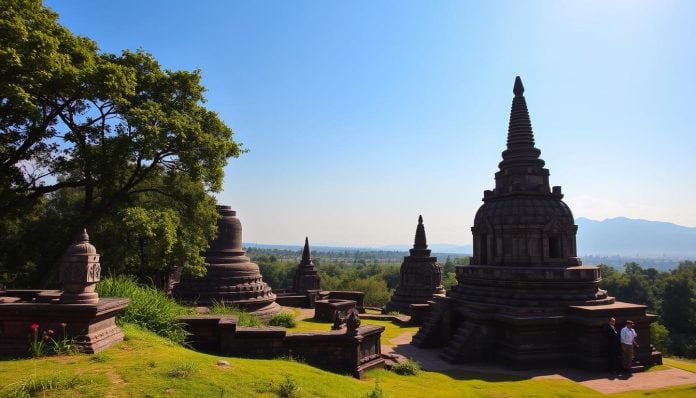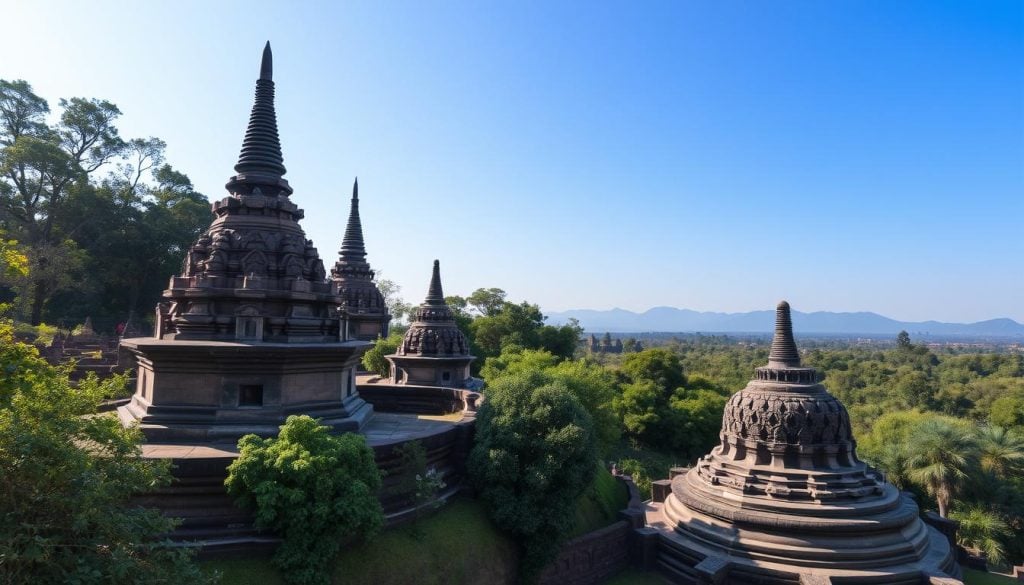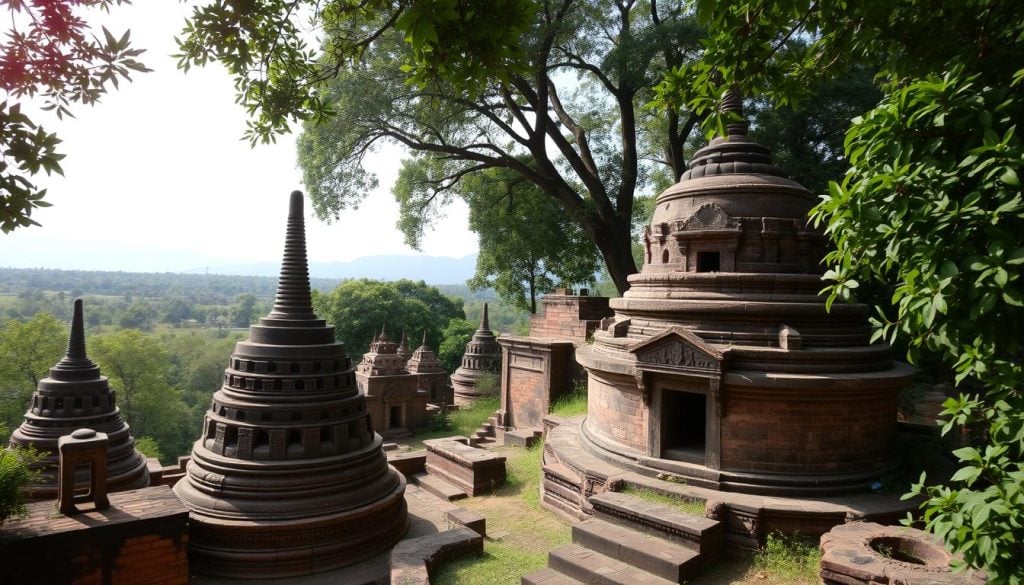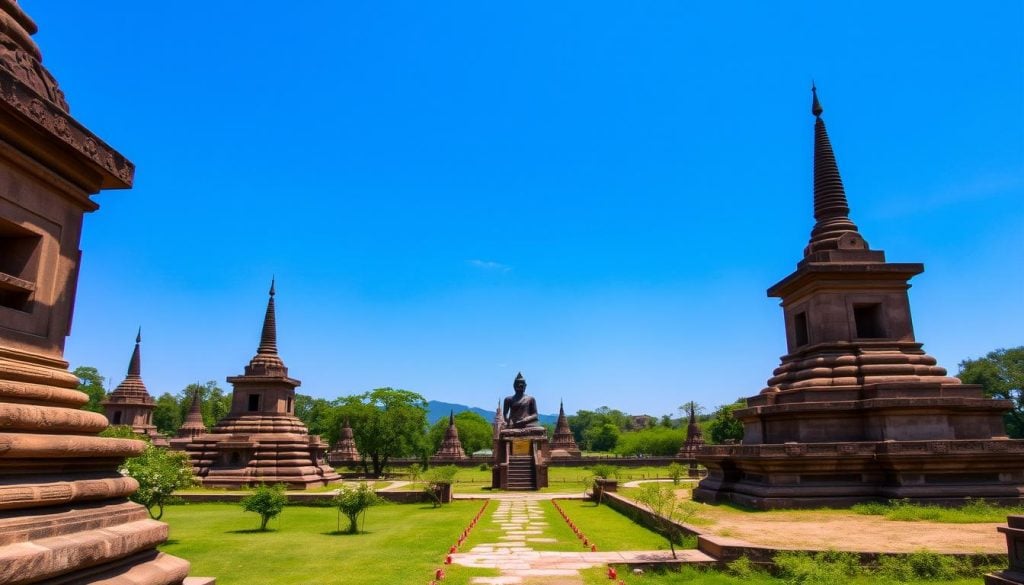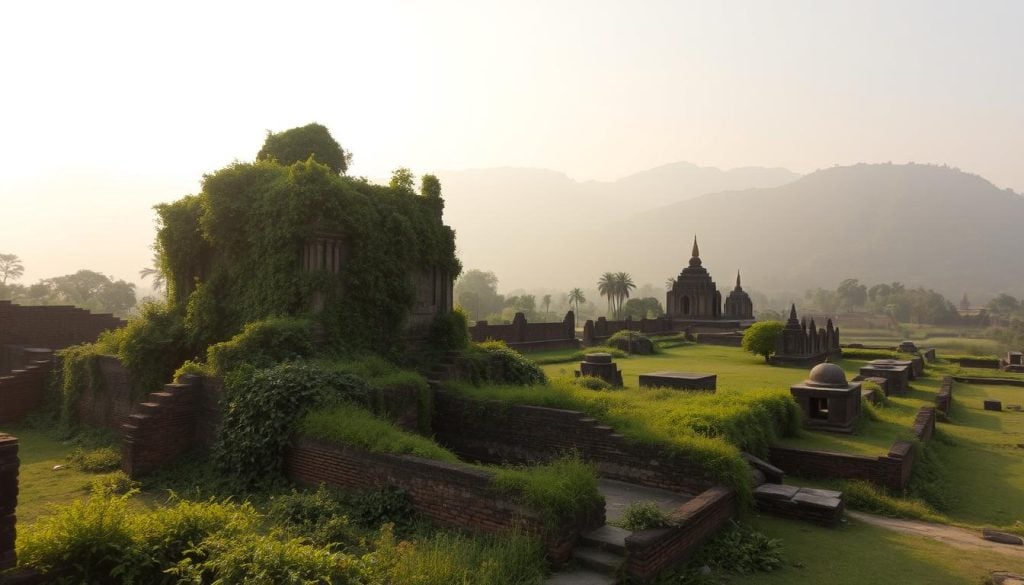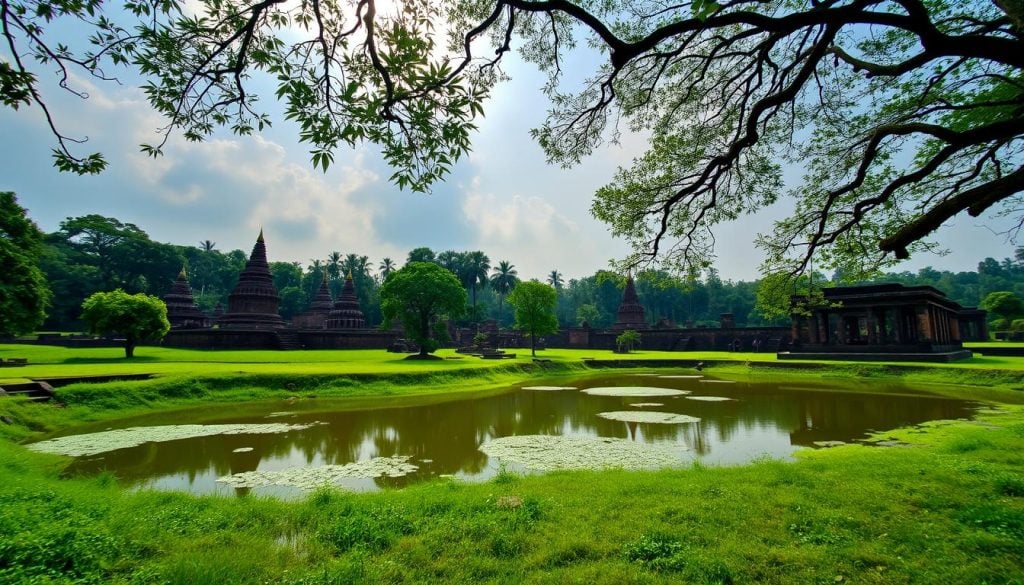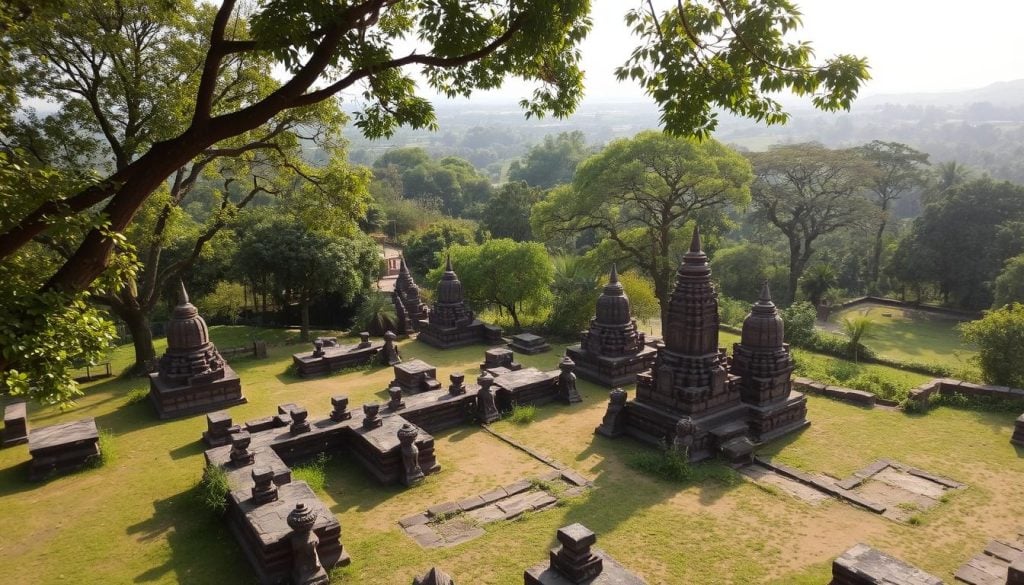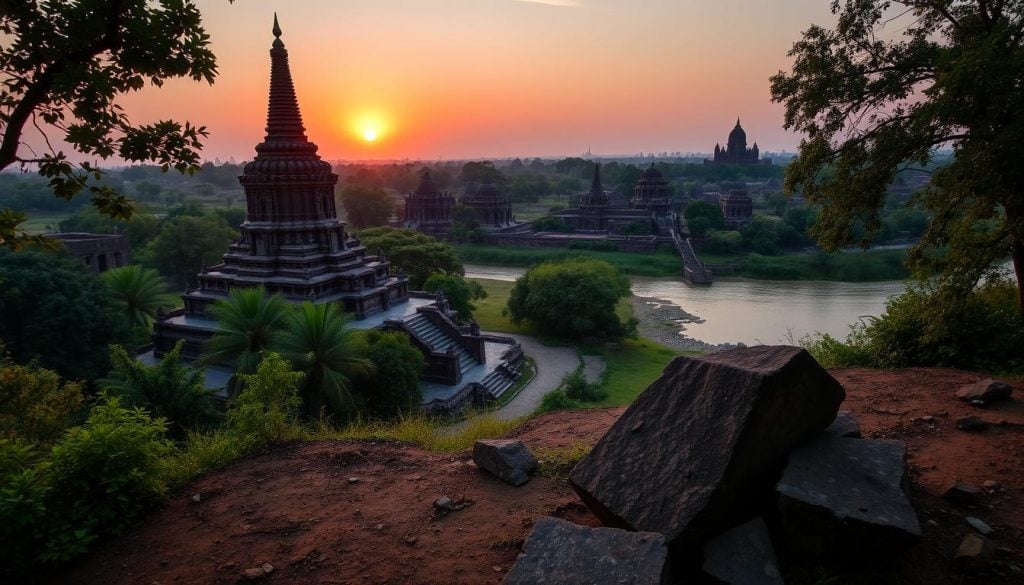Have you ever wondered how a single place could reveal the whole story of Buddhism? Lumbini, in Nepal, is not just where Buddha was born. It’s also filled with ancient stupas and ruins that tell a tale of spiritual growth and architectural marvels.
As you travel through Lumbini and its surroundings, you’ll find a treasure trove of history. The ancient sites in Lumbini date back to the early centuries BC. Each monument near Lumbini shows how these places have influenced millions. What secrets do these ancient structures hold about Buddha?
Get ready to uncover the rich history and captivating stories of the ancient stupas and ruins near Lumbini. This site is not just about amazing architecture. It’s also a place where a culture that inspires many spiritual seekers still lives on.
Introduction to Lumbini and Its Historical Significance
Lumbini is a key site in the world of Buddhism. It is known worldwide for its religious importance. Every year, many people come to visit this place.
It is one of the four main places for Buddhist pilgrims. This shows how important it is in the Buddhist world.
In this magical area, you can find many historical sites near Lumbini. These sites remember important moments in Buddha’s life. They give us a glimpse into the start and growth of Buddhism.
Thanks to archaeological discoveries, Lumbini is home to over 60 historical sites. These sites show the deep spiritual connection of the area.
Lumbini was named a UNESCO World Heritage Site in 1997. It’s famous for its history and spiritual value. The ruins here are not just old; they inspire and reflect for many.
If you want to learn about Buddhism, Lumbini is a must-see. The area has many attractions for tourists. You can explore spirituality or learn about history.
Understanding the Birthplace of Buddha
Lumbini is more than just a place on the map. It’s a key part of Buddhism’s history and teachings. As the birthplace of Siddhartha Gautama, it holds deep meaning. Exploring Lumbini’s history helps us understand its impact on spiritual beliefs and practices.
Historical Context of Lumbini
Lumbini has been important for Buddhist pilgrims and scholars for centuries. Excavations have found ancient stupas and ruins, dating back to the 3rd century BC. These discoveries show the spiritual connection to Buddha’s life and teachings.
Walking through Lumbini, you can sense the history that has shaped the area and beyond.
UNESCO World Heritage Site Status
In 1997, UNESCO recognized Lumbini as a World Heritage Site. This honor highlights its cultural importance. The site’s architecture and history are preserved, thanks to UNESCO’s efforts.
Landmarks like the Ashoka Pillar, built in 249 BC, mark important moments in Buddha’s life. This makes Lumbini a key place for those interested in Buddhism and its history.
| Feature | Description | Significance |
|---|---|---|
| Ashoka Pillar | Stone pillar erected by Emperor Ashoka | Marks Buddha’s birthplace |
| Monastic Complex | Collection of ancient monasteries and stupas | Shows early Buddhist architectural styles |
| Holy Pool | Site of the ancient bath used during the birth | A place of pilgrimage and reflection |
Ancient Stupas and Ruins Near Lumbini
The ancient sites in Lumbini give us a peek into early Buddhism and Buddha’s life. This area is full of history, with many ancient stupas and ruins. These spots draw both pilgrims and tourists, showing the early Buddhists’ art and architecture.
A Overview of Archaeological Sites
Lumbini has many ancient sites that show Buddhism’s rich history. You can see old towns like Kapilavastu at Tilaurakot, where Buddha grew up. The Nishkramana Stupa marks a key moment in Buddha’s life. These sites mix culture and spirituality.
Major Stupas and Ruins to Visit
When you visit, you’ll see important places that show Buddha’s legacy. Some key sites include:
- Mayadevi Temple: This temple has the Marker Stone, marking Buddha’s birthplace.
- Tilaurakot: The ruins here show Buddha’s early life and royal background.
- Kudan: This is where King Suddhodhana met Buddha, showing their family bond.
- Ramagrama: It’s believed to have Buddha’s relics, like his ashes, making it a cultural gem.
Exploring these ancient sites near Lumbini deepens your connection to Buddhism and its founder. Each site has its own story, adding to the tale of Buddha’s teachings and the growth of Buddhism.
Exploring Mayadevi Temple
The Mayadevi Temple Lumbini is a key pilgrimage site, marking Buddha’s birthplace. It’s a center for Buddhist culture and history, drawing many visitors. The temple dates back to the 3rd century BC, making it a significant historical site near Lumbini Nepal.
The Sacred Birthplace of Buddha
This site is where Buddha was born, making it a symbol of spiritual rebirth. Next to the temple is Puskarini Pond, where Queen Maya Devi bathed after giving birth. This adds to the temple’s importance, offering a peaceful place for meditation and reflection.
Significant Inscriptions and Features
Inside the Mayadevi Temple, you’ll see important inscriptions, including those by Emperor Ashoka. His writings highlight the site’s religious importance and its role in Buddhist history. The temple’s architecture and ancient stupas are stunning, making it a key historical site near Lumbini.
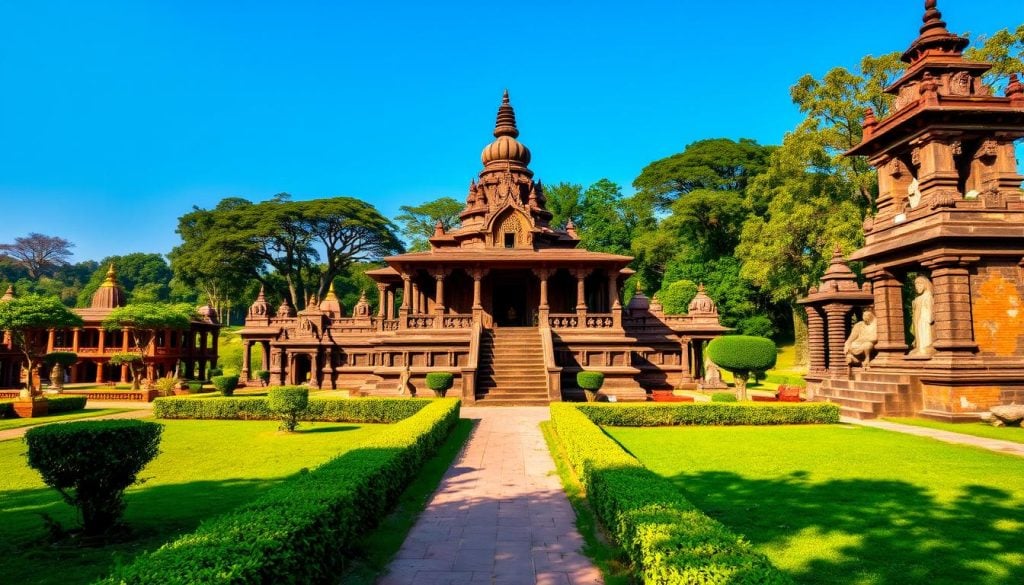
Discovering Tilaurakot and Kapilavastu
You are drawn to the Tilaurakot ruins, where Buddha spent his early years. This place was the capital of the Shakya dynasty. It gives us a peek into ancient life and culture.
Visitors see fort walls, palace ruins, and more. These structures show what life was like when Buddha was young.
Historical Ruins of Buddha’s Early Life
The Tilaurakot ruins are near Lumbini and are very important. They show the skill of the Shakya dynasty’s builders. They also tell us about the politics and society back then.
Walking through the site, you feel the environment that shaped Buddha’s life. It’s a chance to see where he grew up.
Artifacts and Discoveries at the Site
The artifacts from Kapilavastu at Tilaurakot are amazing. You’ll see pottery, coins, and terracotta figures. They show the rich culture of the area.
The Kapilavastu Museum near the site has these finds. It lets you learn more about Buddhism’s history. These discoveries show how Hindu and Buddhist beliefs mixed in the region.
| Discovery | Description | Significance |
|---|---|---|
| Fortification Walls | Remnants of protective barriers surrounding the palace. | Indicates the need for security in a prominent royal city. |
| Pottery | Clay vessels from various periods. | Provides insights into daily life and craftsmanship. |
| Terracotta Figures | Sculptures that reflect artistic styles of the time. | Demonstrates cultural influences and religious practices. |
| Coins | Ancient currency used in trade. | Highlights economic activities and trade routes. |
Visiting Kudan and Its Historical Importance
Kudan is a key pilgrimage site. It’s where Buddha first met his father, King Suddhodhana. This meeting was a turning point in Buddhism, showing the path to spiritual enlightenment.
Place of Initial Meeting with Buddha’s Father
The Kudan historical site is where Buddha met his father after enlightenment. This meeting showed the healing of their relationship. It also laid the groundwork for Buddha’s teachings.
Here, you can think about the change in Buddha. And how it shaped his message of spirituality.
Stupas and Other Significant Structures
At Kudan, you’ll find stupas that mark important moments in Buddha’s life. The Rahula Stupa, for example, celebrates the birth of Buddha’s son, Rahula. It shows Buddha’s personal journey while fulfilling his duties.
These stupas are not just beautiful. They also tell us about the past. They show the architectural wonders of the Mauryan period.
There are also other significant structures near Lumbini. They add to the story of Buddhism’s start. These buildings show the creativity of the Mauryan people in expressing their beliefs.
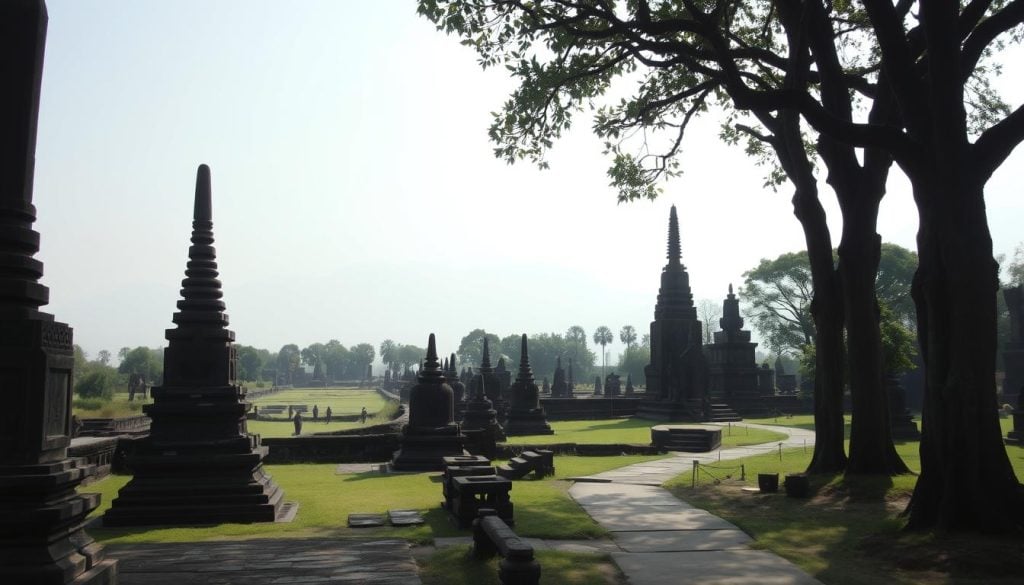
| Significant Structures | Historical Relevance |
|---|---|
| Rahula Stupa | Marks significant events in Buddha’s life |
| Stupas of Kudan | Showcases Mauryan architectural style |
| Kudan meeting site | Represents the enlightenment encounter |
The Spiritual Ambiance of Gotihawa and Niglihawa
Visiting Gotihawa and Niglihawa is a chance to explore their deep spiritual roots. Gotihawa is known as the birthplace of Krakuchanda Buddha. Niglihawa, on the other hand, is where Kanakamuni Buddha was born. These places are important for many who come to reflect and seek spiritual growth.
Historical Relevance of these Sites
These sites are filled with Buddhist history, attracting visitors from everywhere. Their historical significance adds to their spiritual appeal. They are key for those interested in Buddhism’s beginnings and growth.
Key Discoveries and Remnants
Archaeological finds at Gotihawa and Niglihawa reveal early Buddhist practices. Remnants like broken Ashokan pillars show the sites were once bustling with religious life. These finds offer a glimpse into the early days of Buddhism, enriching our understanding of its heritage.
Sagarhawa: The Massacre Site of the Shakyas
Sagarhawa historical site is a place of deep sadness. It marks where the Shakyas were massacred. Knowing its history helps us understand the complex events around Buddha’s life. This site shows the turmoil of the past and reminds us of the struggles back then.
Understanding the Historical Context
Sagarhawa is more than just a massacre site. It’s tied to the conflicts that shaped the Shakya tribe. These conflicts deeply influenced Buddhism. The massacre had a big impact on the area’s social fabric, linking to Buddha’s message of peace.
Memorials and Stupas in Commemoration
Memorials at Sagarhawa honor those who died in the massacre. Visitors find stupas for reflection and meditation. These structures remember the Shakyas and stand for peace and non-violence, key to Buddha’s teachings.
| Feature | Description |
|---|---|
| Sagarhawa Historical Site | A key location regarding the massacre of the Shakyas, significant to both history and Buddhist teachings. |
| Memorials at Sagarhawa | Structures built to honor the Shakya tribe, serving as places for meditation and remembrance. |
| Stupas in Remembrance | Significant stupas that commemorate the lives lost and promote peace, reflecting Buddhist values. |
Exploring Devadaha and Ramagrama
Devadaha is a key historical site, known as Queen Maya Devi’s birthplace. It’s where Buddha was born. The Devadaha significance is huge, showing Buddha’s family roots. People visiting feel a deep spiritual connection, thinking about Buddha’s life and teachings.
Maternal Home of Buddha
Devadaha is where Buddha’s mother’s heritage shines. It’s a place for those wanting to learn about Buddha’s early life. The site’s architecture and ruins are peaceful, perfect for meditation. It makes you think about the values Buddha learned as a child.
Relics and Historical Claims of Ramagrama
Ramagrama is famous for its stupa with Buddha’s relic. The Ramagrama relics are more than just objects; they connect us spiritually to Buddha. Ramagrama’s history shows its role in keeping these relics safe. It’s a place of deep devotion for Buddhists, helping them understand their faith.
| Location | Significance | Notable Features |
|---|---|---|
| Devadaha | Maternal Home of Buddha | Historical ruins, Serenity for contemplation |
| Ramagrama | Home to Buddha’s Relic Stupa | Preservation of relics, Spiritual reverence |
Conclusion
Exploring ancient stupas and ruins near Lumbini is a deep dive into history, spirituality, and Buddhism. Sites like the Mayadevi Temple and Tilaurakot show the life of Buddha and Buddhist culture. It’s not just visiting old places; it’s a way to understand a spiritual legacy that has touched many lives.
Your visit to these sites gives you a deeper look into Lumbini’s cultural heritage. By seeing the remnants and artifacts, you help keep their importance alive for others. Every visit to these ancient places is a way to honor the stories and teachings of this important cultural area.
Your trip to Lumbini is more than just history; it’s a personal connection to a cherished spiritual tradition. Reflect on your time in Lumbini and take with you the lessons and experiences from these ancient landscapes. Your connection to this rich history respects the past and enriches your spiritual journey.

































